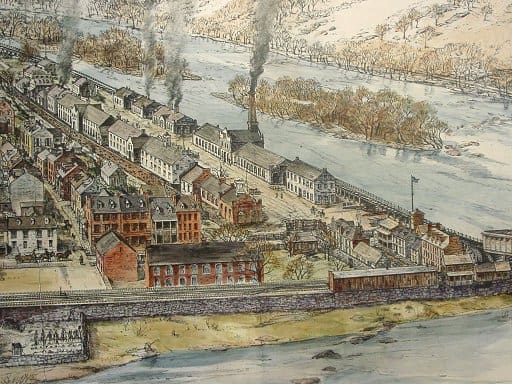The town of Harpers Ferry, Virginia (now WV) was a quiet and quaint little place located at the confluence of the Potomac and Shenandoah rivers. It was regarded as little more than a trading post, boasting only a handful of residents. Once the new federal armory opened in the late 18th century, things changed dramatically. By 1820, the armory had added 12 buildings and 197 employees to the town’s population. On the eve of the Civil War in 1860, the census recorded almost 1,800 residents – quite the uptick from the end of the 1700s!
The early years of production at the Harpers Ferry Armory were quite eventful. Not because of the arms they were making or repairing (which numbered as few as 50 muskets in 1807), but because of what the workers were up to when they should have been making or repairing arms.

Period accounts note than the workers “habitually suspended their chores to share a cup of whiskey.”
After having a drink (or two), they would often “throng to the armory yard to watch dogfights and cockfights, bloody fisticuffs between co-workers, and less belligerent wrestling matches.” My guess is that the fights and wrestling matches stemmed from drinking earlier in the day, but who can really say?
Sometimes the distractions were less raucous. Armorers were known to knock off early to “listen to itinerant evangelists and stump orators and examine wares being hawked by peddlers.” Not unlike the many people today who engage in online shopping between the hours of 9-5. Admit it – you’ve done it.
Workers at Harpers Ferry found all sorts of reasons to party, ranging from “holidays, barbecues, and celebrations” and more, all of which “fostered a carnival-like spirit” that frequently “went on until the small hours of the morning.”
With that much partying and other assorted extracurricular activities going on, it’s a wonder that 1) anything got made there at all, and 2) that anything made or repaired there actually functioned!
Even with all the distractions, production saw a dramatic increase over a short period of time. Just three years after only making 50 muskets, the armory was churning out an annual average of 8-10,000 muskets by 1810!

On April 18, 1861 – one day after Virginia left the Union – 42 soldiers placed barrels of gunpowder throughout the armory’s buildings and blew it all up in an effort to prevent the machinery and stash of arms from falling into the hands of Confederate soldiers.
By the end of the Civil War in 1865, the town of Harpers Ferry had been completely decimated. By 1869, the government had decided not to rebuild the armory and sold all of the remaining equipment at public auction.

Today, much of the town – including the site of the armory – is run by the National Park Service. Visitors today will encounter no street fights, wrestling matches, or anything reminiscent of the “carnival-like spirit” of the early 1800s. The latest census data lists the population at less than 300 people, making it more like the idyllic trading post that it was before the government came to town, and less like the manufacturing powerhouse it was for a brief period in the 19th century.
Logan Metesh is a firearms historian and consultant who runs High Caliber History LLC. Click here for a free 3-page download with tips about caring for your antique and collectible firearms.





No mention of John Brown, huh? That’s kind of like talking about the history of Fort Sumter and skipping over the Civil War.
what do you mean? is harpers ferry now a hot-bed of socialist communist rabble?
Proof????
I stopped by Harpers Ferry years ago because I was interested in the manufacture of firearms. All we heard was drivel about John Brown by the federal officers. It’s strange that John Brown was a psychotic criminal who was hanged by the Union army but somehow he is the focus of the Harpers Ferry legacy.
do they have a p.t.a.?
…ask Jeannie C. Riley…
https://www.youtube.com/watch?v=cF29LZLifV8
Better still, ask Tom T. Hall. He wrote it. And he likes beer. 🙂
Visitors today will encounter no street fights, wrestling matches, or anything reminiscent of the “carnival-like spirit” of the early 1800s.
Gee…took away all the reasons why I wanted to visit.
A serious question –
Weren’t there some noted ‘issues’ with quality control with the mass-produced armory muskets during the ‘War of Northern Aggression’?
No such war happened.
(dives into his flame and bomb proof shelter)
“No such war happened.”
As Yosemite Sam once said :
“Damn Yankees…”
*snicker* 😉
Civil service/government workers haven’t changed a lick in 157 years. Well, maybe the distractions have changed , but, not the malingering and lax a daisy work ethic.
That’s what I thought as well (and I use to be one of them).
I worked for DOD for 42 years. Those who make this kind of comment have NO IDEA!
Comments are closed.